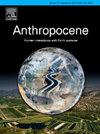Enhanced hydrological disturbance and atmospheric pollution on an ombrotrophic peatland (Greater Khingan Mountains, Northeast China) since 1950s inferred from diatom records
IF 3.3
2区 地球科学
Q2 ENVIRONMENTAL SCIENCES
引用次数: 0
Abstract
Anthropogenic source emissions have caused unprecedented atmospheric environment pollution and natural ecosystem destruction in recent decades. It is necessary to explore the relationships among human, environment and ecosystem in a global change context. Ombrotrophic peatlands are precipitation-dependent and derive nutrients solely from atmospheric deposition, which can document environmental changes continuously. Diatoms preserved in peat sediments are abundant and diverse, and sensitive to hydrological environment changes. Here we reconstructed the historical water table conditions based on diatom from an ombrotrophic peatland in the northern Greater Khingan Mountains, and to assess the influence of climate and human on ecosystem development over the past 150 years. Our results revealed the hydrological condition in Hongtu (HT) peatland was mainly impacted by climate before 1950 AD. HT peatland remained in a pristine state with minimal human interference, as native inhabitants continued to hunt and gather. After the New China was established in 1949 AD, high frequency of fire events caused by rapid population growth, mining and industry destroyed the diatom diversity. Higher water table in HT peatland from 1950 AD to 1965 AD was resulted by higher rainfall. Since 1980 AD, especially after 2000 AD, a suddenly increase of tolerant diatoms species (Achnanthidium minutissimum and Craticula molestiformis) indicated enhanced anthropogenic disturbance. Anthropogenic emissions caused by industrial production and coal consumption increased the atmospheric nitrogen deposition. The abnormal drought of HT peatland was influenced by both climate warming and human activities since 1980s. The recent and strong effects of human activities on peatlands left significantly stratigraphic signals of the Anthropocene in peat deposits. Diatoms have potential to be applied as indicators of long-term hydrological changes in ombrotrophic peatlands, as they are highly sensitive to environmental changes and human disturbance.
基于硅藻记录的50年代以来大兴安岭近营养型泥炭地水文扰动和大气污染加剧
近几十年来,人为源排放造成了前所未有的大气环境污染和自然生态系统破坏。在全球变化的背景下,有必要探讨人类、环境和生态系统之间的关系。近营养化泥炭地依赖于降水,其养分完全来自于大气沉降,可以连续记录环境变化。泥炭沉积物中保存的硅藻丰富多样,对水文环境变化敏感。本文以大兴安岭北缘一个深营养型泥炭地的硅藻为研究对象,重建了该地区近150年来的历史地下水位,并评价了气候和人类活动对该地区生态系统发展的影响。结果表明,1950年以前洪图泥炭地水文条件主要受气候影响。由于当地居民继续狩猎和采集,HT泥炭地保持着原始状态,人类的干预很少。1949年新中国成立后,由于人口快速增长、采矿业和工业等因素导致火灾频发,硅藻多样性遭到破坏。1950 ~ 1965年高温泥炭地地下水位升高是由于降水增多所致。自公元1980年以来,特别是公元2000年以后,耐受性硅藻种类(Achnanthidium minutissimum和Craticula molestiformis)的突然增加表明人为干扰增强。工业生产和煤炭消费造成的人为排放增加了大气氮沉降。20世纪80年代以来高温泥炭地异常干旱是气候变暖和人类活动共同影响的结果。最近人类活动对泥炭地的强烈影响在泥炭沉积物中留下了人类世的显著地层学信号。由于硅藻对环境变化和人为干扰高度敏感,因此有潜力作为营养型泥炭地长期水文变化的指标。
本文章由计算机程序翻译,如有差异,请以英文原文为准。
求助全文
约1分钟内获得全文
求助全文
来源期刊

Anthropocene
Earth and Planetary Sciences-Earth and Planetary Sciences (miscellaneous)
CiteScore
6.30
自引率
0.00%
发文量
27
审稿时长
102 days
期刊介绍:
Anthropocene is an interdisciplinary journal that publishes peer-reviewed works addressing the nature, scale, and extent of interactions that people have with Earth processes and systems. The scope of the journal includes the significance of human activities in altering Earth’s landscapes, oceans, the atmosphere, cryosphere, and ecosystems over a range of time and space scales - from global phenomena over geologic eras to single isolated events - including the linkages, couplings, and feedbacks among physical, chemical, and biological components of Earth systems. The journal also addresses how such alterations can have profound effects on, and implications for, human society. As the scale and pace of human interactions with Earth systems have intensified in recent decades, understanding human-induced alterations in the past and present is critical to our ability to anticipate, mitigate, and adapt to changes in the future. The journal aims to provide a venue to focus research findings, discussions, and debates toward advancing predictive understanding of human interactions with Earth systems - one of the grand challenges of our time.
 求助内容:
求助内容: 应助结果提醒方式:
应助结果提醒方式:


